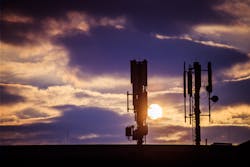After years of using analog and digital alarm communicators, cellular has been a viable means of communications for the security and fire industry for more than a decade. When Apple introduced its latest series of 5G-capable iPhones in 2020, it became official to the American consumer that 5G was a reality.
The evolution of cellular technology has always been driven by a demand for more, faster, better. As the consumer world starts the transition from the limitations of 4G LTE to the new bar set by 5G technology, we continue to expect the same: more data, delivered faster, in more efficient ways.
5G is a new global standard designed to offer more connectivity, with higher speeds, superior reliability, and negligible latency when compared to previous generational technologies. For any technology to be considered 5G, it needs to meet certain criteria.
Inevitably, this will have an impact on fire and security communications technology as well.
LWPA’s Role in the 5G Evolution
As the need for wireless systems evolves, so do the different technologies that are used to satisfy the demand. Whereas 15 years ago, the average cellular consumer would think of their handheld phones as their main interaction with cellular technology, today’s consumer is looking at a more connected world, where devices want to interact with other devices to increase productivity where possible.
Using cellular technology to connect standalone devices and deliver data has grown into a need to have machine-to-machine connections that wirelessly deliver data for many industries. This demand has spurred the wireless IoT movement.
With the rapid growth of the wireless IoT movement comes a new technology: LPWA (Low-Power Wide Area) wireless technology, which satisfies the needs of these types of devices to communicate quickly and reliably within the boundaries of their expected usage.
Understanding LPWA technology is important because it is a technology that caters specifically to machine-to-machine devices such as alarm communicators. Having a technology that focuses on these devices is a big step forward as it adds value in terms of longevity and access. Rather than being tied down to the usual sunsets imposed on consumer devices – an industry that expects and entices consumers to upgrade devices every 1 to 2 years – the use of this IoT-specific technology means that the technology concentrates on devices that are expected to work as standalone systems for many years and prioritize longevity and access.
LPWA has two leading technologies under its umbrella: NB-IoT and LTE-M – both of which are labeled as 5G-ready. LTE-M is the technology that Telguard chose for its next evolution path in alarm communicators.
LTE-M and Alarm Communicators
How does the introduction of 5G cellular technology impact the security and fire communication segment? As an industry, we have dealt with similar evolutions in the past, transitioning to the newer technology when available and prudent; however, this time there is a slightly different path available to alarm communicators.
The use of IoT-specific technologies such as LTE-M will provide added longevity because the technology itself was built around the premise of longevity and with the 5G standard in mind. LTE-M is committed to continue working and evolving through the carrier’s consumer 5G transitions.
Alarm communications still deals with relatively small pieces of information, so while data capacity and speed are attractive features, the main benefit on current systems remains in the added longevity and other parameters like in-building penetration that are improved with LTE-M technology – because of its focus on machine-to-machine devices as opposed to direct consumer interactions.
In terms of data throughput from a broader perspective, it becomes an opportunity to look beyond the traditional communication parameters and think of the alarm communication segment as one that delivers data, which if expanded upon, could mean more than just standard contact ID or SIA events. It could usher in an evolution where a communicator is a vehicle to deliver anything the attached system wants to send, over any medium, as long as it can be delivered as data.
There has always been a small gap between the time that a cellular technology becomes commercially available and the time that the alarm communication industry feels confident enough in the technology to deploy it. We are currently at that point with LTE-M, where confidence is high that it will perform positively and will also add longevity to the market.
The Future of 5G
5G is already here, and LTE-M technology has a solid footprint in the U.S., which is to say that the gates are open for the use of this newer technology in the IoT market. If you have purchased a car in the past couple of years, chances are you had the option to have a remote-control package that lets you lock/unlock your vehicle from a phone app. This is just one of many examples of how different industries are using cellular access in new markets to create a more connected world. The more reliable that a technology becomes, the more it will be used in ways that go beyond its original intent. This is what technologies like LTE-M bring to the picture.
As the cellular carriers continue their aggressive advertisement of 5G consumer technology, the message is reaching consumers in the industry. Coupled with the upcoming sunsets for 3G technologies from AT&T and Verizon, it is natural for consumers – and integrators – to wonder when the 4G LTE sunset will take place.
While it is true that 4G technology will eventually become obsolete, there is no announced sunset date – and for good reason. 5G as it stands today is limited in terms of coverage, and not quite ready to be a standalone technology; therefore, it relies on LTE to complement it. In other words, if today’s handheld consumer were to be as mobile as they are used to, they would not be able to maintain 5G connection everywhere they go.
To achieve the desired standard at consumer level requires deployment of technology like mmWave, which has inherent limitations and will require some time to be fully implemented. Because of this, experts in the cellular world estimate a 4G LTE sunset start at 10 years, and many go considerably higher with some dependencies.
Naturally, even this technology will eventually be replaced by something else – a theoretical “6G” standard. So, the question comes up again: when will LTE-M inevitably sunset? The answer is complex, but at its core, because of the way the standard is written, we would first need to understand when 5G will sunset. Given where we are today, this is not a known horizon, and the same applies to LTE-M.
This means that even though the industry is looking at many years of life for LTE, devices that use this 5G LTE-M technology will outlast even those devices.
Daniel Rosales is Senior Director of Technical Service and Support for Telguard, a business unit of Ametek Inc. Request more info about the company at www.securityinfowatch.com/10215328.




